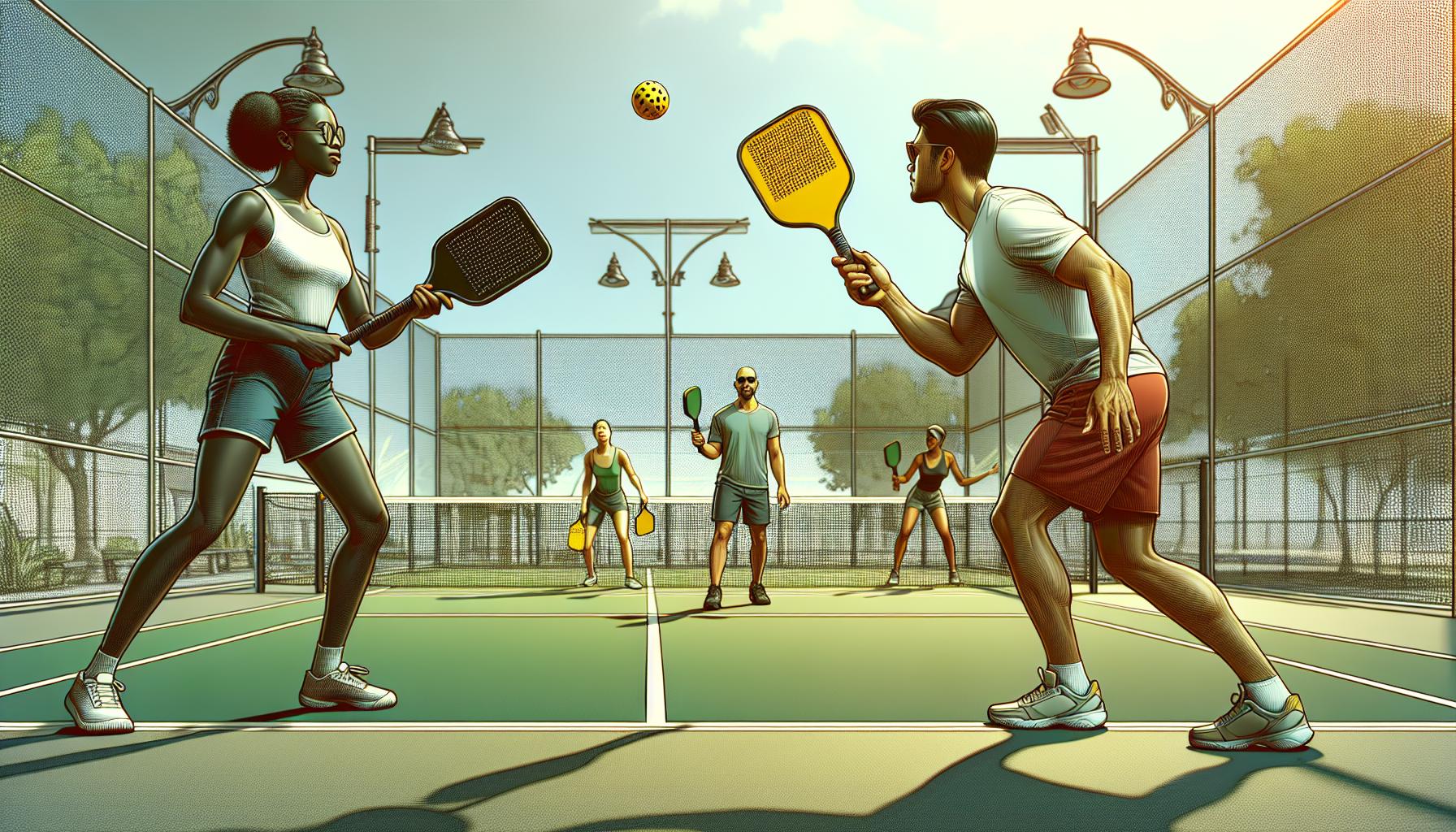Pickleball’s popularity is skyrocketing, and it’s no wonder why. It’s fun, social, and easy to pick up, making it a hit among people of all ages. But before you grab a paddle and hit the court, there’s a bit you’ll need to know to play your best game.
Understanding the basics of pickleball rules can seem daunting at first, but don’t worry. We’ve got you covered. From serving to scoring, this guide will walk you through the essentials, ensuring you’re well-equipped to join in on the fun. Whether you’re looking to play competitively or just enjoy a casual game with friends, knowing the rules is the first step to enjoying this exciting sport.
Court and Equipment Overview
Before diving into the nitty-gritty of pickleball rules, it’s crucial to familiarize oneself with the basic layout of the court and the equipment needed for play. A standard pickleball court measures 20 feet wide by 44 feet long, including lines for the non-volley zone (also known as “the kitchen”) that spans 7 feet from the net on both sides. The net height is set at 36 inches on the sidelines and dips to 34 inches in the center. Understanding these dimensions helps players position themselves and strategize their plays effectively.
Pickleball Equipment includes paddles, which are smaller than tennis rackets but larger than ping-pong paddles, and a ball that resembles a wiffle ball but is slightly harder. The paddles are usually made from composite materials, which contribute to the game’s unique blend of control and power during play.
- Paddles: Necessary for striking the ball. They come in various materials, including wood and composite options.
- Balls: Specifically designed for pickleball play, with outdoor and indoor variations present. Outdoor balls typically have 40 holes and are designed to withstand windy conditions.
- Net: Standardized to meet pickleball specifications, ensuring fair play.
Players might also consider comfortable athletic wear and proper shoes as part of their gear to enhance mobility and prevent injuries on the court. While the paddles and balls are the primary pieces of equipment, these additional items can significantly impact a player’s performance and enjoyment of the game.
When preparing for a game or practice session, checking the condition of the equipment is vital. The right paddle can make a significant difference in how the ball is hit, and using a ball designed explicitly for pickleball ensures accurate play. Whether players choose to invest in personal equipment or use what’s available at public courts or clubs, understanding these basics is key to getting started on the right foot.
Moreover, for those planning to play outdoors, considering the wind factor and choosing the right type of ball can be decisive in maintaining control over the game. The differences between indoor and outdoor balls mean players may need to adapt their strategies and styles of play according to where they are playing.
Serving Rules and Techniques

Pickleball has gained immense popularity for its fun gameplay and blend of tennis, badminton, and ping-pong elements. As beginners dive into the sport, understanding the serving rules and techniques is essential for a strong foundation. Let’s explore the key facets that every player needs to know.
When it comes to serving in pickleball, servers must follow specific guidelines to ensure fair play. A serve kicks off the point and can set the tone for the ensuing rally. First and foremost, servers should serve diagonally, aiming for the opposite court’s service area. The serve must clear the non-volley zone, commonly known as the kitchen, and land within the bounds of the diagonal service box.
Serve Position and Motion
Servers must keep both feet behind the baseline during the serve, and the serve must be underhand. The paddle must contact the ball below the waist level, and the paddle head must not be above the highest part of the server’s wrist at the point of contact. This rule ensures that serve power is not overly dominant in the game. Moreover, the server’s arm must move in an upward arc, and the ball must be hit in the air, without bouncing on the court. These stipulations help maintain the serve’s intended difficulty level and keep the play balanced.
The Two-Bounce Rule
An integral part of pickleball serving rules is the two-bounce rule. It requires that the ball bounces once on each side of the net before players can return it without it bouncing. This rule gives the receiving team a fair chance to return the serve and encourages longer rallies, making the game more enjoyable.
Serving Strategies
Mastering serving techniques can give players a strategic advantage. Here are a few strategies to consider:
- Placement Over Power: Instead of focusing solely on power, placing the serve in difficult-to-reach areas of the opponent’s court can be more effective.
- Varying the Serve: Mixing up serves by alternating between deep serves and short ones can keep opponents guessing and off-balance.
- Using Spin: Applying spin to the serve can make it more challenging for opponents to return.
Practice Makes Perfect
To excel in serving, consistent practice is key. Players should work on their serving techniques, focusing on accuracy, consistency, and spin. Playing against various opponents and in different conditions will also help players adapt and improve their serving game.
In-Game Rules: Dinking, Volleying, and Non-Volley Zone

When diving into the world of pickleball, understanding the in-game rules is crucial for every beginner. This section covers the essentials of dinking, volleying, and navigating the non-volley zone – three areas that significantly impact gameplay.
Dinking is a soft, short shot made in the no-volley zone, aimed just over the net. It’s a strategic move designed to make it difficult for opponents to return with power. Mastering the dink allows players to control the pace of the game, drawing opponents to the net and creating opportunities to exploit their weaknesses. Unlike power shots that aim for the baseline, the goal of a dink is precision and placement rather than speed.
Volleying refers to hitting the ball before it bounces. In pickleball, volleying is a powerful tool, especially when executed close to the net, allowing players to catch their opponents off guard. However, there’s a catch: the non-volley zone, or the “kitchen,” prohibits players from volleying within seven feet of the net. This rule prevents players from dominating the game with aggressive net play, ensuring a balance between strategy and power.
The Non-Volley Zone (NVZ), commonly known as the kitchen, spans 7 feet from the net on both sides, creating a space where players cannot volley. Stepping into the NVZ to volley results in a fault, making it a critical area to navigate carefully during play. The NVZ encourages a variety of shots and strategies beyond power hitting, including the aforementioned dinks, lobs, and groundstrokes, keeping the game accessible and challenging for players of all levels.
For beginners, mastering movement and shot selection around the NVZ is vital. It requires awareness of one’s position in relation to the zone, as accidentally stepping into it while volleying can quickly turn the tide of a game. Players should practice moving in and out of the NVZ with agility, ensuring they’re ready to volley when outside the zone and prepared to dink or use groundstrokes when within its boundaries.
Scoring System and Winning

Pickleball has a unique scoring system that’s both straightforward and necessitates a bit of strategy to master. Unlike some racket sports, only the serving team in pickleball can score points. This rule adds an extra layer of strategy, making serving a crucial part of the game.
Games are typically played to 11 points and must be won by at least a 2-point margin. In tournament play, matches can go up to 15 or 21 points, also requiring a win by 2 points. This system ensures that games remain competitive and that a clear winner is established.
How Scoring Works:
When the serving team wins a rally, they score a point. The server continues to serve, moving from one side of the court to the other with each point scored. This continues until a fault is made, and the serve then passes to the opposing team. In doubles, each team member serves before the serve transitions to the opponents, except at the very start of the game, where the first serving team starts with just one server.
Here’s a simplified breakdown:
- Serve is made
- Rally is played
- If the serving team wins the rally, they score a point
- Serve switches sides within the team until a fault; then serve transfers to the opposing team
Keeping Score:
A unique aspect of pickleball scoring is how it’s announced. Scores are called out as three numbers: the serving team’s score first, the receiving team’s score second, and finally the server number (1 or 2 in doubles). For instance, “5-3-2” means the serving team has 5 points, the receiving team has 3 points, and the server is the second server on their team.
Winning the Game:
To win a game, a team must reach at least 11 points and be ahead by at least 2 points. This can lead to prolonged games if teams are closely matched. It’s not uncommon for games to extend well beyond 11 points as teams battle back and forth for the 2-point lead necessary to clinch the win.
Conclusion
Diving into the world of pickleball opens up a fascinating mix of strategy and skill especially for beginners. Understanding the scoring system and how a game unfolds is crucial for anyone looking to get into the sport. It’s not just about hitting the ball back and forth but knowing when your team can score and how to leverage the serving advantage. Remember the key to victory lies in reaching at least 11 points while staying two steps ahead of the competition. So grab a paddle, find a partner and put these rules to the test on the court. Who knows? You might just find your new favorite sport.














0 Comments